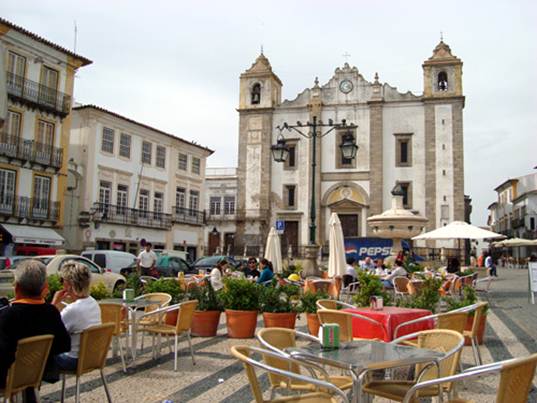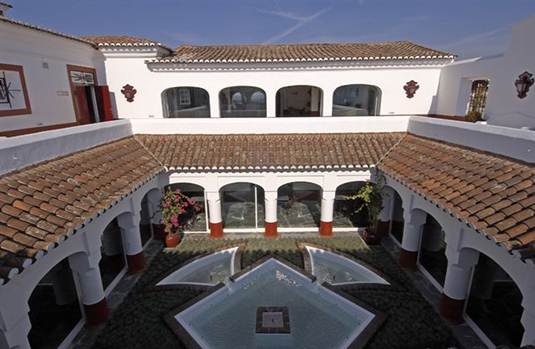Evora managers to be not only an
outstandingly beautiful and well-preserved city, but also functional and
user-friendly. Almost everything worth seeing lies within the ring of
fortifications, and nothing is further than a half-hour walk from anything
else. So it makes sense to leave your car in one of the various car parks
outside the walls and take to the cobbled streets of the centre, heading
perhaps for the Praca do Giraldo, epicentre of Evora’s civic life, or making
your way to the nucleus formed by the Roman temple, the Pousada de Evora,
Lóios, the city museum, the old library – good example of the Portuguese genius
for conservation, with time-worn wooden shelves and ranks of leather-bound
books – and the cathedral.
the
Praca do Giraldo, epicentre of Evora’s civic life
The grandest of Evora’s many imposing
religious buildings, the cathedral (knows as the Sé) crowns the town and can be
seen for miles from the surrounding countryside. Begun on the 12th
century, it has a solid, gloomy aspect and crenellated walls giving it the look
of a fortress. Its Gothic grimness is surpassed only by that of the church of
São Francisco’s infamous Capela dos Ossos (“bone chapel”), a chilling piece of
baroque interior design that employs thousands of human skulls and bones.
Beyond a skull-encrusted window lies a children’s playground, the shouts and
laughter in poignant contrast to the gruesomeness within.
After a couple of days pounding the cobbles,
you may feel you have earned a respite from Evora’s panoply of palaces and
convents. Within easy reach of the city by car are the neolithic remains of
Almendres, the historic towns of Montemor-o-Novo and Arraiolos (famous for its
handmade carpets), and the immense new Alqueva reservoir, focus of various
original tourist enterprises including cruises and watersports.

Herdade
do Esporão
If you’re going to the medieval town of
Monsaraz, pretty as a picture on a hilltop above the reservoir, you might stop
for lunch on the way at Herdade do Esporão. This 1,800-hectare private estate,
owned by the Roquete family, was established in 1267 after the conquest of the
Moors. Formerly a wheat-producing farm, it now has 600 hecteres of wines under
the aegis of the vines and currently makes some of Portugal’s most interesting
wines under the aegis of Australian oenologist David Baverstock (as well as
four million litres per year of the estate’s standard brand, Monte Velho). Over
lunch at the on-site restaurant, I learned of plans to create a fully-fledged
“wine tourism” operation based in the property’s 13th-century tower,
with tours of the winery, tastings in a delicated centre and nature walks in
the estate, which has a lake, woods and olive groves.
The Alentejo in general, and Evora in
particular, is a good place to be if you happen to be interested in food and
wine. The region’s gastronomy is fondly regarded by the Portuguese for its
down-home simplicity, which reflects the reality of a poor, agricultural area where
bread, olives and wine were (and still are) the pillars of the diet. Of Evora’s
remarkable number of restaurants (there were 370 at the last count) the most
famous is Fialho, a temple of local cuisine and a reliable source of such
classics as acorda (bread-and-garlic soup), sopa de cacao (dogfish soup),
ensopado de borrego (lamb casserole) and pezinhos de coentrada (pigs’ trotters
in coriander sauce)

Hotéis
ao redor de Évora
However, further investigation brought me
to what was certainly the culinary highlight of my long weekend. The
deliciousness on offer at the Botequim da Mouraria is out of all proportion to
the diminutive size of the restaurant. Grab a place at the bar (it seats only
10, and there are no tables) and let Domingos Canelas serve you whatever his
wife Florbela has decided to prepare in her tiny kitchen at the back. There may
be scrambled eggs with asparagus, partridge with red cabbage, grilled local
cheese with oregano, or tenderloin of porco preto, perfectly grilled with a
tomato-and-onion salad on the side. There will certainly be local wines;
Domingos is an expert and the walls of the bar are lined with more than 140 of
the Alentejo’s finest vintages.